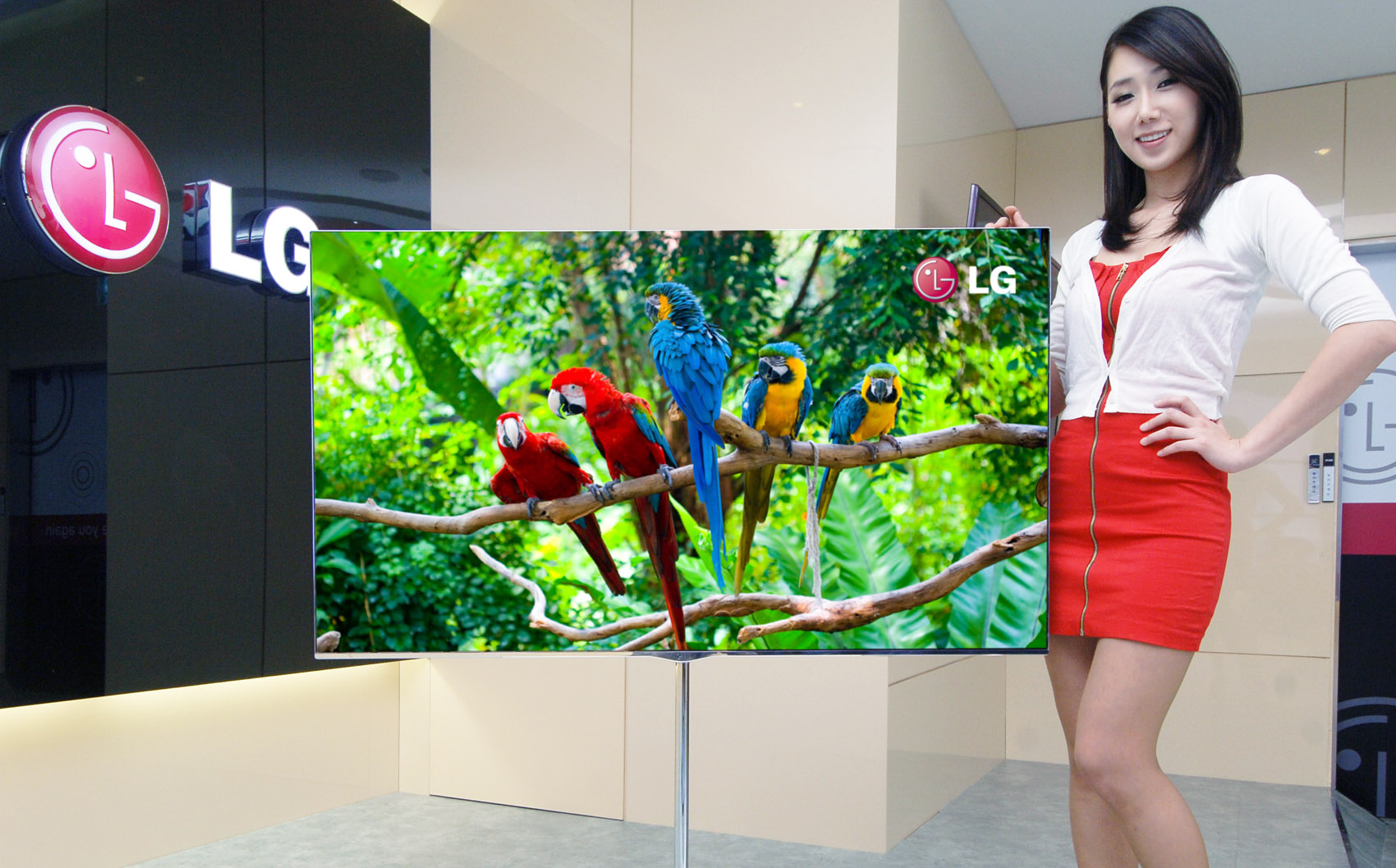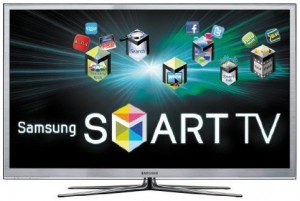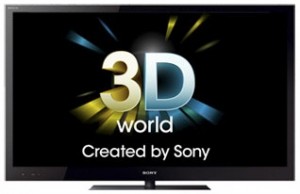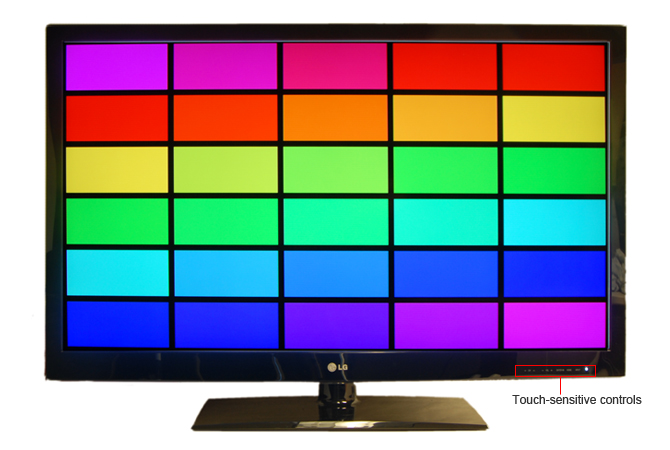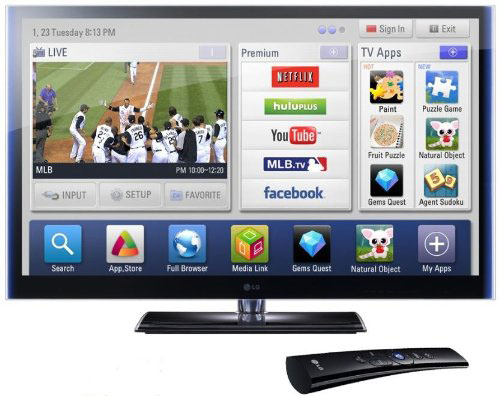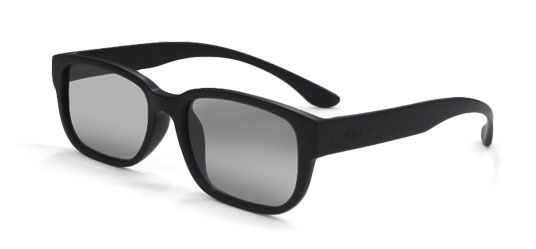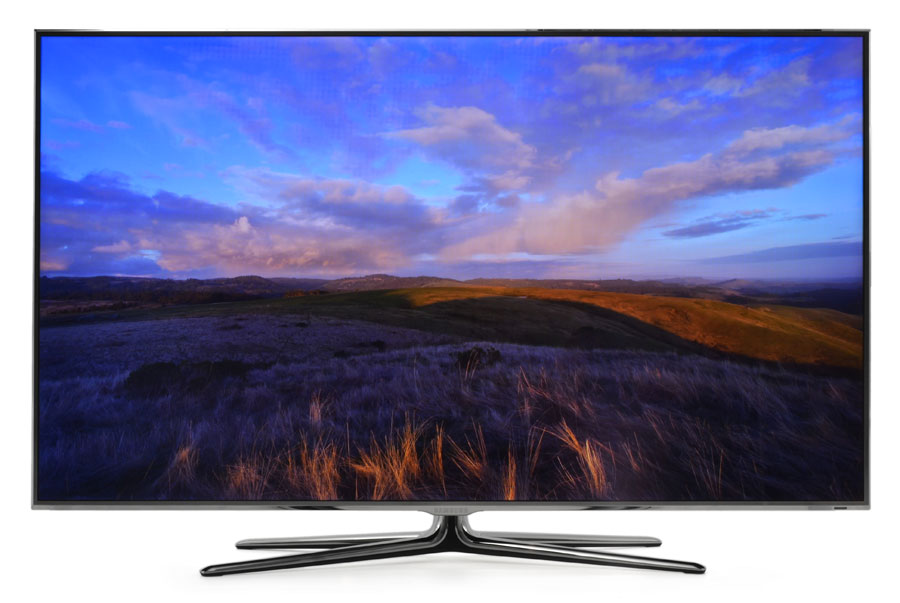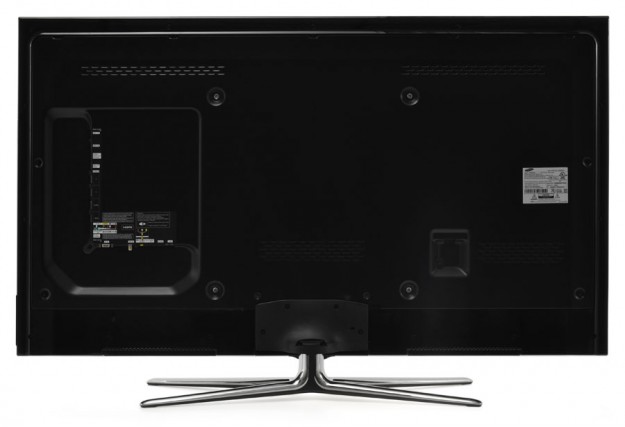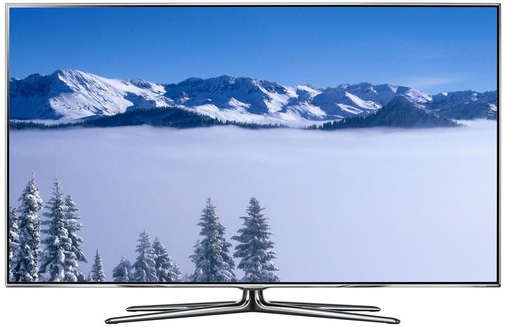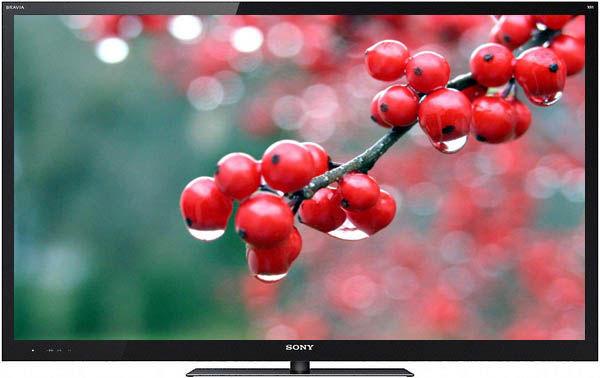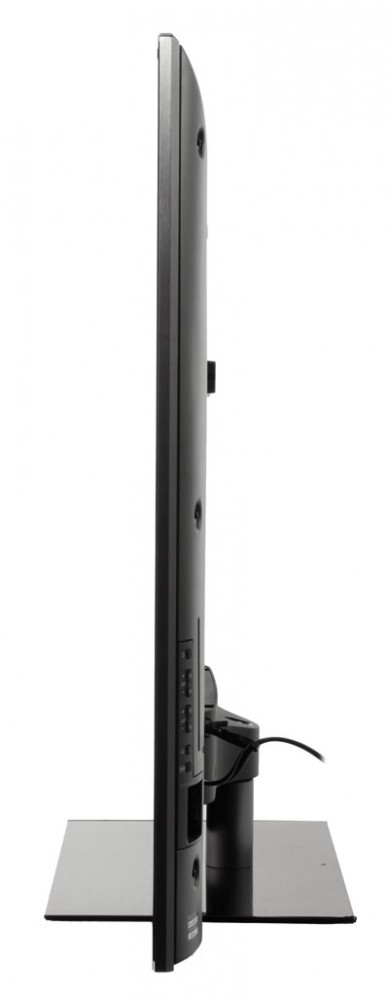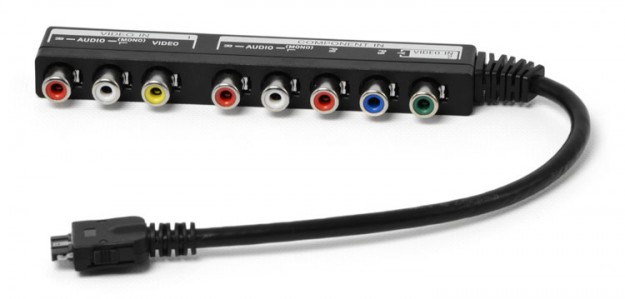An LED TV is in fact a type of LCD TV. The only real difference between the two are their backlights. Instead of using an LCD TV’s compact fluorescent backlight, and LED TV is outfitted with tiny, efficient, ultra-bright light emitting diodes. Not only are these displays impeccably vivid and bright, but they are also more energy-efficient and can be exceptionally thin because of the small size of the LED itself.
Although LED backlit TVs are more expensive overall, they generally offer far better contrast and inkier blacks. It would seem that as soon as we all were getting settled with our LCD TVs, along came the LED TV to make things even better. While LED TVs, both edge-lit and full matrix, might have their own set of unique disadvantages, most tech professionals and users agree that overall, the very best LCD TVs on the market use LED technology. So with that in mind, we’ve taken a look at all of the major LED TVs to come out this year and compiled this year’s list of the top 3 LED TVs of 2012. Enjoy!
Top 3 LED TVs of 2012
3. LG 47LW5600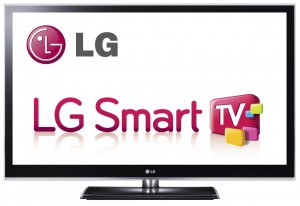
The LG 47LW5600 brings a top-notch digital 3D display to an affordable price range using its passive glasses technology.
What’s in the box?
You’ll be getting the LED panel, a swivel stand and eight Phillips screws to put the two together. We were a bit surprised at how lightweight the stand really was, but as long as it met safety standards, the lighter, the better! The LED TV also comes with four 3D glasses, a wireless network adapter, and two remote controls.
The first is a standard remote with backlit buttons and the second is a Magic Motion remote with a strap that resembles a kind of Wii game controller. Finally, you’ll also have an owner’s manual as well as a digital copy too. Once we got everything assembled, we connected a standard 3D Blu-Ray player and watched Avatar in 3D for what seems to be the gazillionth time.
Features
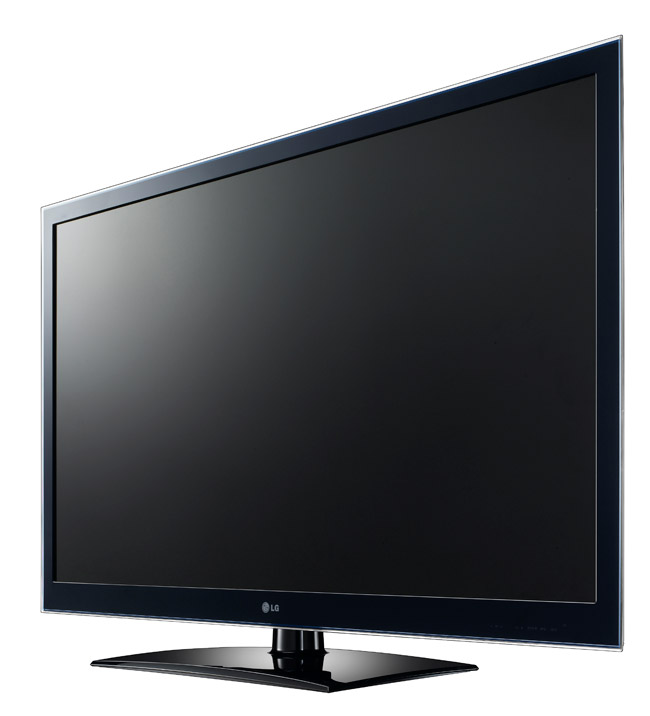 Based solely on outward appearances, the 47-inch LG 47LW5600 is just like any number of black-edged flat panel HDTVs, but it does have pretty sweet translucent edging. The screen is framed by a black bezel, so it doesn’t have the nicer floating pane of glass look that are popular with the premium LED TV sets.
Based solely on outward appearances, the 47-inch LG 47LW5600 is just like any number of black-edged flat panel HDTVs, but it does have pretty sweet translucent edging. The screen is framed by a black bezel, so it doesn’t have the nicer floating pane of glass look that are popular with the premium LED TV sets.
But even then, the overall look is more than acceptable by our standards. Along the lower bezel is the 3D emitter, touch buttons for controls (you’ll probably never use), in addition to remote control and intelligent auto light sensors that dim the display when no one is around to watch the TV.
Down-firing stereo speakers at the bottom of the panel are rated at 10 watts apiece, but it lacks the subwoofer you usually would find in the high-priced models. This LG HDTV model measures 43.9 x 26.9 x 1.2 inches and weighs 40.8 pounds. On the left side of the set is a jack pack offering two USB inputs and four HDMI inputs. The back has the usual component, A/V, RS-232C, RGB-in Ethernet and other connections that should cover all the various gadgets you’d want to hook up to a TV without any issues. The only noticeable thing left out was an SD card slot that would have been handy for photographers.
Performance
One of the latest controversies to come out of the tech world lately seems to be the battle between active and passive 3D HDTV technology. LG, Vizio, and Toshiba jumped the passive boat, while almost all the other major HDTV manufacturers stayed with the active shutter glasses system.
The active-shutter system, also known as “Full HD” 3D technology, does have a higher quality 3D image, costs a whole lot more, and requires expensive, heavy 3D glasses. On the other hand, the passive system uses cheaper and lighter 3D glasses just like the pairs you get at your local movie theater. The HDTV itself also costs a lot less, but finely-detailed 3D resolution isn’t really as good. The technology is known as “Film Patterned Retarder”, or FPR. LG refers to this passive 3D tech as “Cinema 3D”. You can do your own research into FPR technology, but basically from what we gather passive just lets you watch 3D at home for a far better price.
The LG 47LW5600 is a 1080P 120Hz HDTV featuring Led Plus with something called “local dimming” – LG’s term for ledge-lit Led backlighting with 12 addressable segments for the 47-inch edition. We’ve like the results of this technology versus traditional CCFL LCD TVs since it’s narrowed the quality gap with plasma displays, which still remain on top. Black levels, contrast and color rendition are improved with this TV’s LED technology. The panel is a whole lot lighter and thinner as a result, while energy-efficiency is a whole lot better too.
The main remote control is pretty straightforward, with a backlit button layout that’s made just for basic television controls. Although the LG 47LW5600 doesn’t have official THX certification, the HDTV has two ISFccc settings so that you can use the Picture Wizard II to calibrate your TV set. We checked out the standard and cinema modes too, while the Intelligent Sensor setting adjusts parameters for ambient room light. The set also comes with a Magic Motion controller that acts as an almost-buttonless remote for navigating through menus. The menu display itself is decent, not having anything particularly bad or good to say about it. As soon as the Magic Motion controller is synced, a cross will appear on your TV screen when you aim it at the display, acting kind of like a computer cursor.
Sitting back about 2 meters from the screen, we watched scenes from Avatar on the LG Cinema 3D. What’s cool about the 3D glasses is that you don’t have to turn them on at all, or worry if they’re functioning properly or have enough power for a long viewing. Also, the surrounding room doesn’t completely dim which occurs when active shutter technology kicks in. This subtle darker look is not anything to worry about, just a little different. What’s really cool is that the flicker-free LG glasses are extremely lightweight, comfortable and there are no problems about recharging the glasses or changing batteries. Not to mention they’re very cheap. You could even use those Real3D glasses you use at a movie theater.
All of our doubt about the passive 3D technology disappeared as soon as we began watching the opening menu scene of the Avatar 3D Blu-Ray. It really looked great – crisp and eye-popping. Skipping through to take a look at the more action-oriented scenes, we have to admit being very much impressed by the arrows, bullets and gas canisters popping off the screen. The only downside is that just like at the movie theater, you can’t move around with the lighter glasses and still watch the 3D. The effects get all jumble as soon as you move your head a lot to the side. Sure, the effects weren’t as good as the pricier 3D LED TVs we’ve seen, but the shear price difference as compared to quality is just outstanding. And that’s why it’s made it in at number 5 at our list of the top LED TVs of 2012.
The Samsung UN55D8000 has a beautiful picture quality with an incredible thin display. Anyone who’s been TV shopping recently at their local electronics retailer has undoubtedly seen the Samsung D8000 series at one point. It’s really hard to miss it, considering its almost non-existent bezel display and super thin frame. We’ve found that once people lay eyes on the Samsung UN55D8000, it’s really hard to look away. You just get stuck staring at it, probably until your significant other finally finds you and drags you out of the store.
What’s in the box?
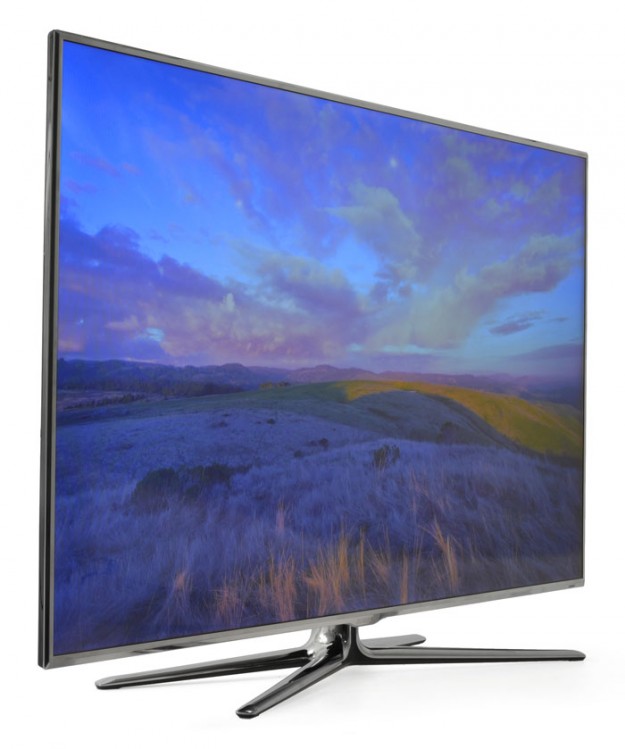 The Samsung UN55D8000 weighs in at an impressively light 35 pounds and measures 48.5 x 27.8 x 1.2 inches. Yes, it’s only 1.2 inches deep. There’s not a whole lot to grab onto when you’re pulling this bad boy out of the box so I’d suggest have a friend with you to help get it set up. In addition to the display there is an x-shaped TV stand and a two-sided remote control, and the usual suspects when it comes to paperwork. Lastly, two active 3D glasses are included as well.
The Samsung UN55D8000 weighs in at an impressively light 35 pounds and measures 48.5 x 27.8 x 1.2 inches. Yes, it’s only 1.2 inches deep. There’s not a whole lot to grab onto when you’re pulling this bad boy out of the box so I’d suggest have a friend with you to help get it set up. In addition to the display there is an x-shaped TV stand and a two-sided remote control, and the usual suspects when it comes to paperwork. Lastly, two active 3D glasses are included as well.
Putting it all together with the stand is fairly straight forward, and we like that the TV sat a lot more securely than many other LED TVs we’ve seen. The only real downside is that the actual look of the stand is not on par with the rest of the TV in terms of quality and aesthetic appeal. The stand tries to copy the chrome bezel appearance, but while the bezel of the TV is made of solid looking and feeling metal, the stand has a kind of cheap plastic feel with a low quality chrome finish.
The bezel itself is a whole lot smaller that it looks online and in commercials. We had already taken a look a quite a few reviews online with plenty of photos, so we had an idea of what to expect. But when we finally came around to seeing it for ourselves, it was just unbelievable how crazy thin the bezel actually looked. It looks very nice even on its own, without turning anything on. But of course when we finally fired it up the added effect of the picture took the experience to all new heights.
The wafer-thin bezel has an illuminated Samsung badge on the bottom center of the set. The badge is extremely bright on its default setting, somewhat unsettling because of the bezel’s overall subtlety. But luckily this light setting can be adjusted to be a whole lot dimmer (we went a step further and just turned it off entirely).
One of the biggest drawbacks to making such a thin HDTV is that you basically run out of room to put the essential inputs. You have only a very shallow inset on the back that accommodates the LED TV’s only bay of inputs and outputs. So for the Samsung UN55D8000, that translates to a little extra work to connect HDMI cables.
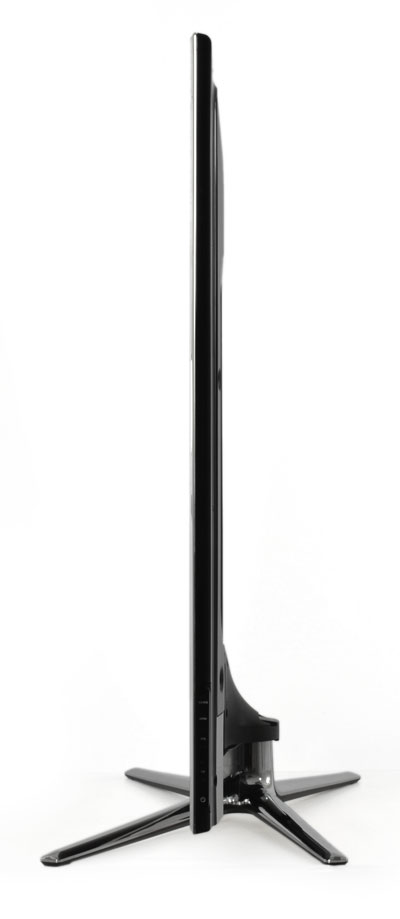 Even worse, these inputs become even less accessible when wall mounted. That includes the three USB ports which would probably need to be accessed after the set is installed on a wall. Samsung definitely missed the ball on that note.
Even worse, these inputs become even less accessible when wall mounted. That includes the three USB ports which would probably need to be accessed after the set is installed on a wall. Samsung definitely missed the ball on that note.
Features
The Samsung UN55D8000 comes with all of the latest technology and features from Samsung. It’s would take way too much time to cover them all, as it’s an article in it of itself, so we’re just going to touch on some of the more important ones.
The Micro Dimming Plus feature is Samsung’s main local dimming component. For those of you who are not familiar with local dimming, it lets certain sections of the backlight to be dimmed while others are left to shine at full brightness. This give the display a better contrast and brightness that is most noticeable accompanied by a dark background with bright areas interjected onto the picture. On regular HDTV sets, the area around the brighter spots is gray and even darkish blue instead of black. With Samsung’s Micro Dimming Plus, you get a much more accurate picture overall.
In this model, Samsung incorporated edge lighting along the left and right sides of the TV display, rather than along the top and bottom edges. This allows letterbox bars to be darker and more uniform. The set has a full 1080p resolution with 3D capability, with a built in 2D to 3D conversion feature. The Smart Hub is an interface for accessing all the internet essentials. With it, you get Netflix, YouTube, Hulu Plus, Facebook, Twitter, and a whole long list of other cool applications with and integrated search engine as well.
As for DLNA compatibility, AllShare is Samsung’s solution. It’s a lot faster and simpler to work with than other DLNA interfaces we’ve seen. With AllShare, you can stream files over the cloud from devices like your smartphone, tablet, and PC. The main thing that got us hooked was how easy it was to use.
Trying out our Galaxy Tab as a remote control, we were able to access media not just on the Tab, but from every other DLNA device within the same cloud network. The Samsung UN55D8000 gives you the choice of a wired Ethernet connection through an LAN port or its built-in 802.11b/g/n wireless adapter.
Samsung advertises its “Ultra Clear Panel” as being resistant to the effects of ambient light. In a way, this means that the panel absorbs bright lights in order to minimize wash-out and keep the picture looking super clear. We did get a little light refracted from the windows, but overall Samsung stayed true to its word.
Performance
The Samsung UN55D8000 out-of-box picture quality was a little below par we have to admit. But this was easily explained by its default settings. Fortunately, some slight adjustments to brightness and contrast brought it to something really worth seeing for yourselves. Colors were much more accurate, but remained vivid. The balance between brightness and contrast was much improved, as well.
With the adjustments finally made, we once again checked out Avatar. We noticed some unbelievable texture detail in the skin of both the humans and the aliens. The film is loaded with all kinds of blues and greens and the set did very well reproducing all of them, catching even the subtlest of hue differences.
The foggier scenes went by without any obvious banding, and this is probably the best we’ve seen from any other TV in this respect. Without any additional help from Samsung’s motion smoothing technology, we felt that the motion was both smooth and natural, with hardly any noticeable judder or motion blur.
The TV’s Netflix and Hulu Plus media rendering was equally, if not more, impressive. HD versions of some popular TV shows looked incredibly smooth and well resolved – a whole lot better than we’ve seen on any other HDTV. We also really enjoyed the informational interface bar that let us know that we were watching HD or standard definition, depending on our bandwidth at the time.
The 3D performance on the Samsung UN55D8000 was very good to say the least. Not too much crosstalk, and the color really came through the tinted, active 3D glasses. The display gave a confirmation with our glasses were connected and let us know that 3D content was sensed. We may not be huge fans of active 3D, but we felt that on this television really provided a picture that was stunning. It just felt a whole lot easier and smoother to watch 3D on this TV. With its super-thin bezel, the Samsung UN55D8000 takes on a window-like quality in its 2D mode. Truly something to just sit back and look at.
The Sony Bravia XBR-46HX929 tops our list with near-perfect contrast ratios and color through local LED dimming, making it one of the very best mid-size LCD TVs on the market today.
This model features the latest local dimming technology, a feature that attributes to its near-perfect contrast and black levels that can even surpass that of some plasma TVs. Of course, premium technology does mean a hefty premium retail price, but its feature set and sheer performance potential makes the Sony Bravia XBR-46HX929 an extremely attractive option for those looking to get all the cinematic performance of a plasma in an efficient and super-slim LCD sized package.
What’s in the box?
The Sony Bravia XBR-46HX929 comes in a considerably smaller package and weighs in at around 42.8 pounds. With it, you’ll be getting the display, a stand, a component video/AV dongle, power cord and the usual bells and whistles of user manuals and paperwork. Putting the display and stand together was no major project at all, although the overall stability of the final product was a bit less than we had hoped for.
Features
The display for this model is simply incredible. The bezel may have been a bit thicker than the Samsung, but there was something inexplicably attractive about the way the glass panel merged with the edging into one seamless piece, keeping its surface utterly flat for a final product that’s seemingly edgeless. Apart from its barely noticeable status LEDs, only the Sony logo breaks up an otherwise flawless front surface.
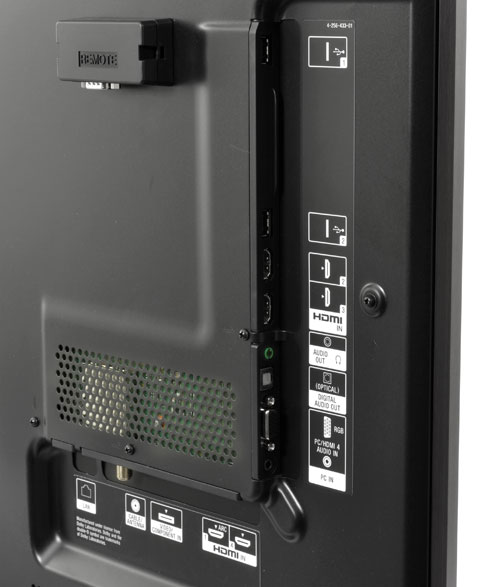 The rear to the display is almost as flat as the front, save for an RS-232 box that adds a little unnecessary depth to the set. As for its connectivity, Sony got it all right. We were able to find two USB ports, four HDMI inputs, PC video and audio inputs coaxial cable input, and Ethernet jack, optical digital audio output, headphone output and a space to connect the provided dongle for old-school component video and composite jacks, should you want those connections. All of the inputs are split up between the lower back portion of the back panel and the upper left side for a those discreet cable connections for easy access.
The rear to the display is almost as flat as the front, save for an RS-232 box that adds a little unnecessary depth to the set. As for its connectivity, Sony got it all right. We were able to find two USB ports, four HDMI inputs, PC video and audio inputs coaxial cable input, and Ethernet jack, optical digital audio output, headphone output and a space to connect the provided dongle for old-school component video and composite jacks, should you want those connections. All of the inputs are split up between the lower back portion of the back panel and the upper left side for a those discreet cable connections for easy access.
Within it, Sony has packed a whole bunch of extras as well as suite of Internet content applications. We really love the presence sensor, which uses a built-in camera to monitor the room for any subtle movement. If there isn’t any sort of movement for a specified duration, the display turns off. It also displays a big warning sign if someone gets to close for safe viewing. That same sensor works with the TV’s optional ambience sensor to modify the brightness according to lighting conditions and can adjust picture based on viewer position in the room as well. As for internet content, Sony offers built-in Wi-Fi to get at them if an Ethernet cable isn’t available. Netflix, Amazon VOD, YouTube, Hulu Plus, Pandora – just to name a few.
We also really enjoy the remote control Sony offers with its series of TVs. A power button located a third of the way up on the back of the remote is actually a really nice touch, as is the large navigation wheel near the front. Most of the critical buttons are illuminated by the remote’s blue back light, but the button that launches the back light isn’t ergonomically placed to be honest.
Although you can view full 3D picture at its 1080p resolution, the active-shutter glasses needed to enjoy it are not included. At its retail asking price, we really would have expected to see at least a pair included, maybe even as a promotional gift in the very least, but for now, expect to dish out about 70 bucks a pair. But on the plus side, the glasses are USB rechargeable much like the Sony PS3 controllers.
Performance
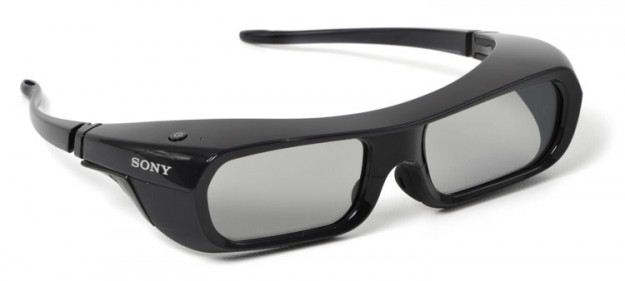 For video content review, we stuck with our trusty Avatar Blu-Ray, but we also spent quite a bit of time streaming YouTube and Netflix videos, as well as video and music stored on a networked computer.
For video content review, we stuck with our trusty Avatar Blu-Ray, but we also spent quite a bit of time streaming YouTube and Netflix videos, as well as video and music stored on a networked computer.
We spent enough time calibrating to come to the conclusion that the Sony Bravia XBR-46HX929 performs extremely well right out of the box, although is standard picture setting was a little on the brighter side and colors were a bit intense. We did find that the display’s cinema setting offered a more natural picture very close to our own manual calibration, but we found ourselves actually preferring some of the TV’s brighter settings during out tests in rooms with lots of windows and sun exposure.
In a nutshell, the Sony Bravia XBR-46HX929 offers one of the best picture qualities we’ve ever laid eyes on. The black levels on this model are unbelievable, as was its high contrast ratio. Color accuracy was a close to flawless as possible in today’s market, pulling off the smallest fine graduations between oranges and browns in some of our usual testing materials that we’ve never noticed on any other LED TV before.
We also found the reds on this display to be some of the very best we’ve ever laid eyes on, surpassing that of many high-end plasma TVs as well. We spent hours on this Sony model and were consistently impressed by how engaging and aesthetically satisfying picture quality was.
3D performance was something to marvel at as well. Where we would usually notice some flicker other 3D systems that rely on active shutter glasses, the Sony Bravia XBR-46HX929 remained flicker free and the image, beyond the eye-popping 3D, was still razor sharp with excellent color and contrast. We usually work pretty fast through some of our previous 3D evaluations, but we actually very much enjoyed the effect this time and found ourselves lingering on Avatar 3D a little longer than we had to.
